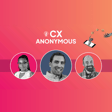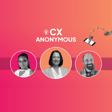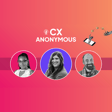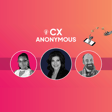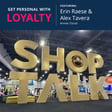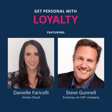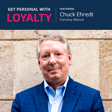Become a Creator today!Start creating today - Share your story with the world!
Start for free
00:00:00
00:00:01

The Stakeholder Game: A Company Culture of Loyalty
The Loyalty Lounge Powered by Annex Cloud Presents CX Anonymous: The Stakeholder Game: A Company Culture of Loyalty. Loyalty as a company culture keeps your program prioritized and stakeholders engaged. Alex Tavera, Head of Strategy at Annex Cloud, discusses loyalty program success beyond implementation for translating results across regions and the organization.
Transcript
Introduction to CX Anonymous with Amber Collins and Alex Tavera
00:00:05
Speaker
Welcome back to CX Anonymous, the series where we provide tactical and practical advice on successfully executing customer experience and loyalty. We don't care who you work for, just how it got done. We're going to continue our discussion of the stakeholder game.
Alex Tavera's Experience in Loyalty Programs
00:00:19
Speaker
I'm your host, Amber Collins, Product Marketing Manager, here with Scott Sherson, Product Solutions Director, and our guest today is a loyalty strategist, Alex Tavera. Thanks for joining, Alex. Please tell us a little bit about yourself.
From Design to Execution of Loyalty Programs
00:00:34
Speaker
Yeah, thanks for having me. Well, I've been in the loyalty game for a while now. I worked on building and designing loyalty programs for a number of years, probably across 25 different clients in multiple different industries. And then for the last five years, I've been running my own programs with a couple of different companies. So I've been on both the design and fun side, and then the actual, okay, we got to get this thing implemented and get the work done and measure success and show those results. So it's been a good ride.
00:01:04
Speaker
Yeah, I love that. I mean, we all know that there are so many opportunities in this space that there's also a lot of challenges that come with executing
Post-Implementation Stakeholder Management
00:01:12
Speaker
it. Of course, this season's topic, managing stakeholders mainly has been focused on getting that project up and running, but today I'm really excited to bring you on, Alex, so that we can examine what's next and explore the ongoing requirements of those stakeholders after we've got a project such as loyalty that is so large and so visual
00:01:32
Speaker
implemented. Being that we are on the vendor side, we fully support the implementation and then you have a handoff to our customer success team, which is there to support this ongoing team for the rest of your life with us at Annex Cloud. In your experience, Alex, once you're over that hump and once you get that handoff to customer success, what happens next?
Engaging Cross-Functional Teams Post-Launch
00:01:58
Speaker
So I think what's really important just to ensure that you do have a seamless handoff is during the actual project and strategy design phase, moving into implementation and integration, you have a cross-functional team that's created, right? So you have the marketers that will be associated, business owners, IT, finance, et cetera. Don't lose that.
00:02:23
Speaker
You need that CFT, you need those captains to still be in the game, even after the project has been launched and the customer is now seeing the program.
00:02:31
Speaker
So I make sure to have weekly meetings as you're moving through implementation, but making sure to go to either biweekly or monthly after that and bringing all of those people back to the table to ensure that everything is moving smoothly. So are there any hiccups or issues with how the consumer is perceiving the program? Are enrollments down? Are we seeing any of the projection that we wanted to see in terms of the financials?
00:02:55
Speaker
I think making sure you set that up is crucial. Then your customer success manager is also a huge partner. I have mine ready to go on text. We call each other on cell if we need to, and then obviously having standing meetings. But I think that's crucial in terms of building a strong relationship with them so they can help troubleshoot things really quickly if there was something that you wanted to try or do and didn't maybe know how to do it. But I would say that that's really core. Those team members, those captains being in the game with you ongoing,
00:03:25
Speaker
as a part of the responsibility of their role since you've now launched loyalty.
Research for Consumer Engagement and Program Adjustment
00:03:29
Speaker
And the second piece I'd say is don't forget about ongoing research. So whenever designing a program, I always want to make sure to do a lot of both quantitative and qualitative analysis to ensure the design of the program is going to engage the consumer
00:03:43
Speaker
but don't lose that either, right? As soon as you actually launch, of course you'll see data coming in, you'll see what campaigns or actions they're interested in and engaging with, but don't forget to keep talking to them and asking them how it's going, do they like it, and rewarding them for that as well, because they're sharing some really rich data with you. So I would say those are two big focuses that I've always
Benefits of Hyper-Care Scenarios
00:04:04
Speaker
had. Once the launch is over, just making sure I don't lose all those great team members that wanted to help me out, and then make sure I do not lose touch with my customer.
00:04:12
Speaker
So two things I wanted to bring up about that is you're bringing everybody along as you're doing that. Do you see, talk to me about the value of like a hyper care scenario. Like everybody's like, you know, hands on, eyes on, you know, at a super involved level. Do you find it easier to sell the idea of staying on a project and not jumping off because of a hyper care scenario? Or talk to me about that transition.
Aligning Programs with Regional Behaviors
00:04:40
Speaker
100%, I think that in an implementation, especially one with a third party vendor that is willing to be there from start to finish for the implementation, configuration and integration, they're teaching everybody as well. Because there's a lot of people in other business units that might not really understand loyalty from a business angle or why this is important or why it's important to continue having the conversation. So I think hyper-care is crucial because they see the value. They see the value of working together and being that strong cross-functional team.
00:05:09
Speaker
Also, what's nice is that if you launch pretty successfully and seamlessly because of that, they get a lot of kudos from leadership. This was a really exciting project. It went super easy. You did great. You have another opportunity to keep them in the fold because if and it should,
00:05:25
Speaker
Loyalty performs well and changes the desired behavior of the consumer, increases incremental revenue, et cetera. That's more kudos and more wins to share as a team. So it's not just the program manager. This was a team effort across the company and you get loyalty to be even more of a company culture fit. It becomes the core of the strategy because there's so many people working on it and wanting to see success. Thank you. So on the second point about the research, a lot of programs have a tendency to do all walk run either as a
00:05:54
Speaker
strategy design or in a more regionalized market, you know, rollout, either technical or just simply regional based. First of all, do you see a lot of success in doing this crawl walk run? And my second part of that is, would that skew some of the research because you're getting a more limited focus on data because of that?
00:06:20
Speaker
Potentially, I would say that in a program that I've done that was just US based, we wanted to make sure that when we did a pilot scenario, we needed to get a good mix of stores.
Structuring Pilot Programs for Regional Differences
00:06:30
Speaker
So we had the online channel, but our stores and our store volumes are really important. So yes, our top performing stores are probably going to do very well with loyalty, but are we actually moving the needle on some of our bottom performing stores?
00:06:41
Speaker
I think that was one aspect of you really want to structure your pilot right, and you want to ensure that you have metrics of success. Is this the right audience and a good mix of your consumer segments? Then secondly, do you have a strong forecast of metrics of success for the pilot that then translate into your overall forecast and says, oh yeah, if the pilot hits this, this, and this, we know that the expansion plan should achieve the P&L forecast that we put together with finance.
00:07:09
Speaker
To their point, though, there are regional differences. So if you're doing a global program and you want to start in one region, you want to make sure that the design of the program considers all different segments you may have. So if Japan performs differently or has a different type of dynamic or consumer sentiment than the US or the UK or Dubai, et cetera, you want to consider that so that the design will work holistically. But this market, we might see more traction in these aspects of it or these components just because it's this market.
00:07:39
Speaker
However, when we launch in the next country, these are some of the components that their survey results had said. So this is maybe how we might change a couple of the aspects of the program to make it more engaging for that consumer. And then again, you're looking at results. So are we seeing the desired behavior change? And then when you talk with the consumer,
00:07:57
Speaker
in follow-up surveys, do they like it? Are they engaged? Do they want to see anything different? And then making sure that your platform has the capabilities for you to be nimble so that you can change or pivot, not too far away from your overarching design, but maybe some certain campaigns or aspects that you can then take advantage
Mitigating Risks in Loyalty Programs
00:08:13
Speaker
of.
00:08:13
Speaker
So Alex, speaking of those regional and global risks, right? Because even if just doing business to business, not even trying to understand those nuances with the customer, there are risks to that culture side of things and really diving into those and cultural faux pas.
00:08:33
Speaker
So aside from sort of regionalizing or localizing brands that are global, what are their risks to the ongoing success of loyalty programs? Do brands face particularly how does something like a SaaS management platform that is constantly innovating that program as well? How does the innovation plus the consumer, the consumer wants, where are those holes? Where are those red flags? Where are those risks?
00:08:59
Speaker
that a program manager should try to mitigate from the start and have ongoing monitoring of. So it's all about level setting expectations. So letting them know, here's the two to three year roadmap that we see for loyalty. We're going to start with a base earn and burn. We're going to start with two tiers. We might grow to three depending on what the metrics tell us and how our consumers engaging with the program.
00:09:22
Speaker
And here are some other actions and ideas that we also want to launch in the future. So making sure that that roadmap is really clear. Leadership is completely level set on, okay, this is what we get for phase one, two, three, we
Communicating Program Phases to Leadership
00:09:34
Speaker
get it. All tied to financials. That's really critical.
00:09:37
Speaker
And then the other part, too, is that ensuring that you continue to have time with leadership to show how the progress occurs, because loyalty sometimes doesn't you don't see that beautiful big incremental revenue picture, maybe until a few sales cycles, right, because you're trying to change their behavior and get them to maybe take another trip or increase their basket size.
00:09:56
Speaker
You know, depending on what industry and if you're in coffee, you're gonna see that fast because people come in daily for coffee at times. If you're a furniture store, it might take you a while because you need to have some time to develop that engagement with them based on how often they purchase that commodity or that product line or that service or that equipment from a B2B company, right?
00:10:16
Speaker
I think that's really important. The other piece to that again with that importance of the CFT, level setting that expectation with your internal IT if you need anything from some new web pages that might have to be developed to engage this or requiring any type of lift on their end, that really helps just keep everything on the same page and level set across the board. That helps you avoid the red flags or issues that I've seen. The problem is that if that does flag and you weren't prepared for it or it wasn't level set,
00:10:44
Speaker
that's when loyalty starts to get backburnted. Then all of a sudden, this new idea might start taking traction and might take away from your support. That's one thing I would highly recommend. Always level set expectations and plan for three years out. Real quick, for the people listening at home, can we define CFT?
Global Organizational Alignment for Stakeholder Support
00:11:03
Speaker
Oh, cross-functional team. Yes. Sorry, I'm really into TLAs, three-letter acronyms, so my bad on that. We just got to make sure that we get that in there, but please go ahead, Scott.
00:11:12
Speaker
Sorry, what I was thinking is to help with that global alignment with that overall structure, I think it is also aligned to how the business operates in these different regions. Somebody like Travel and Hospitality, I have an expectation that I travel wherever I go, you already know who I am. But somewhere, an organization that might have a different organization, they have to resell the idea to other regions. So it's not that it necessarily gets back, Bernard, it's just the other region
00:11:42
Speaker
you know, hasn't bought into loyalty yet because they operate a little bit differently than another region. I think we've seen a lot of organizations that say once X region drops, the others will fall. Others are like, we have to resell it every single time. Tell me a little bit more about where is that easier to do? Is it easier to resell to another organization because you have done your ongoing research, you have some of that data, or is it
00:12:09
Speaker
harder to do the more global expansion because of some of those regional differences, although a singular program. A lot of it is tied, you're exactly right, is how the business runs and the mechanics of the business, but also the org structure. Making sure that at the highest level, whoever might be overseeing either all the brand managers across the globe, or whoever's overseeing all of marketing retention and loyalty across the globe,
00:12:34
Speaker
those people have to be the ones that are very clearly bought in, and then similar to level setting expectations and forecasting out the things that will change in the program to engage them. Also forecasting out who needs to be involved across the org and when do they need to get involved. Should we get everybody on the same page and aligned before kickoff? Even though, yes, you're in Australia, you're not going to go until year two, but you're a part of the conversation, you understand what the point of this is, and you understand how you'll be impacted and need to shape your team,
00:13:02
Speaker
in order to support it. So I think org structure alignment is crucial, not only to get stakeholders to agree and support the initiative, but that all the working team that's going to have to deliver this knows what they're supposed to deliver, knows how best to deliver, and has a voice in that conversation. I would say that's really critical if you're going to do a very large global program, is that full alignment of that top owner and then all their direct reports.
00:13:26
Speaker
You can comment on this next part if you'd like. I've also seen where when you are doing global and each region has a bit of a nuance where there's a tendency for each of the other regions who want local knowledge or representation. Like you don't understand Australia unless you have people in Australia. You don't understand people in Germany unless you have people in Germany. So I've seen that it's very difficult to resell into organizations like that where it is more of an
00:13:58
Speaker
nationalistic view of how the members act and behave.
Adapting Frameworks for Regional Audiences
00:14:04
Speaker
Yeah, I would say in those instances where we've come across that and where I've seen success from clients,
00:14:10
Speaker
is that they will take the approach of this is your baseline framework. This is the structure of the program. These are all the new bells and whistles and components of a program that you can use to influence the consumer. How you influence them with your creative, with your copy, with your promo selections, that can be regionalized. And that's where I think
00:14:30
Speaker
they get the most support where, oh, okay, I get that I tie to this so that the mechanics of the program work and function across the board so we can measure success globally or regionally. But for my specific region, I know that I'm going to be able to talk to them the way they want to be talked to, show them the products, services, whatever, in the right way that I know that they'll react or transact.
00:14:51
Speaker
I think that's a critical part is definitely considering that localization aspect, but it doesn't necessarily mean you have to completely change the program in every single region where this is a paid membership program and this is the points-based and this is keeping that foundational framework so everyone gets it, but then adding that flavor more through your creative and copy and assets, that's where I think I've seen the most success and the most engagement from those teams being like, oh, I can support it, but I'm able to speak to my consumer the way I know they like.
00:15:19
Speaker
I think that circles back to something you were saying earlier about ongoing research and sales cycles, because there is a tendency for brands with longer sales cycles to focus solely on that. But if you take a loyalty program of the caliber that we're used to working with, where there are more social engagements and non-transactional engagement, where you can start to see some quick wins and quick hits with that, there are some benefits to ongoing research, because there are
00:15:48
Speaker
unique things, but then that also circles back to that regional team managing those different tools because they know the people. Yeah, and I really like what you said about interactions and being able to see those quickly. So if you want more people or more penetration of your app, so rewarding for app download, really giving some nice point balances on there or some special benefits if you download it as part of the loyalty program and gating it in loyalty, you're gonna see the enrollments that are associated and you're gonna see the actions that are taken to download the app and the reward they're getting.
00:16:17
Speaker
So you can have really quick wins. And again, loyalty is all about changing or creating, you know, getting the consumer to take actions to deliver a desired behavior from the business, right? And also rewarding them, making them feel good and part of that community.
Embedding Loyalty into Company Culture
00:16:30
Speaker
And so that's absolutely a great one is, can I get them to engage and interact with me, refer friends, et cetera? Because those are other things that I desire as a company, while I might have to wait to start seeing if the transaction behavior is also changing and the financials are coming through, again, because the sales cycle might be a little longer.
00:16:47
Speaker
So I love that, you know, we've talked about how are you going to resell it in the region and Alex giving them the framework and letting sort of letting that localized experience be taken over by the local team. And it's cloud certainly enables marketers to do that and to help with that brand consistency. Cause that's always a risk too, when you're talking about regions is delivering that brand consistency. But I also want to go back to in that vein where you said loyalty as a company culture and how allowing that sort of
00:17:17
Speaker
localization based off of that framework starts to include people that it does become company culture. Talk to me a little bit more about that loyalty as a company culture. How does that get expressed in internal
00:17:31
Speaker
What kind of communication does that equal external to customers?
Cross-Department Loyalty Discussions
00:17:35
Speaker
How does that shape the brand's mission, value, and purpose when loyalty is a company culture? Because I don't think anybody's ever put it that way on this series, at least, so I'd love to just hear a little bit more about that. Really, what you want to have is that in any meeting that you're doing, especially if it is about the customer base, having people in the room that are on marketing or not even on marketing is asking that question of, well, what should we do for loyalty?
00:18:00
Speaker
So we are making these new feature enhancements for our app or we are going to redesign this part of our web. What should we do for loyalty though? What is their experience going to be? Once you have that ingrained because people know from the metrics usually is that our loyalty members spend more. They come in more frequently and they become advocates of us and they're engaging on social etc.
00:18:19
Speaker
Once that starts happening, that's when you know you've moved the needle. And that's not only in the marketing team where your CMO is always asking that question as well, but all of a sudden you start hearing about it from finance. You start hearing about it from IT and ensuring that it starts becoming a constant topic. So as a program manager, anytime you can, you should be interjecting that. Oh, that's a great idea.
00:18:39
Speaker
But what about loyalty? What could we do for loyalty to enhance that even more or make it more special for those members? But that's what I've seen as like loyalty becomes a part of the culture. And of course you see this in airlines, hotels, where, you know, a huge majority of your consumer is a member and the currency is extremely valuable to them. But that's what you want to start seeing or get, that's the ideal state. As a program manager hearing your CEO say things like, well, what are we doing for loyalty? I love that. And being a marketer, what are we doing for loyalty? Because it's also,
00:19:09
Speaker
part of this not necessarily a pyramid but sort of concentric circle where this is why this is called CX anonymous because loyalty is the core and then CX is around it and just in general valuing that part of the business for what it can do and its potential and setting those expectations on the results that it will
Shaping Strategies Through Feedback
00:19:30
Speaker
get. Many times
00:19:31
Speaker
it's all down to sale, sale, sale, sales, sales. But we all know that there are so many metrics that come before a sale that signal that you will get that metric. We have to care about that full spectrum of behavior. That's what I love about loyalty because not only does it get them to identify themselves and opt-in so that we can track that behavior, but they are sending up flags and signals all the time back to the marketer about what is working, what is resonating, what they want to see.
00:19:59
Speaker
Then you take those metrics, you take that information, and you proliferate it across the organization, product development, merchandising, e-com, mobile app, in-store customer experience, and you just really start to see how loyalty data can move the needle in so many different areas.
00:20:16
Speaker
uh it's not always about member sales it's really about getting that feedback motivating them to get those feedback motivating to say hey i love this brand and i want it to continue and listening to them and listening to them so when we talk about loyalty as the company culture hearing you say how you know that ideal state i think that then it transpires in the customer side of things as people who
00:20:37
Speaker
are constantly talking about your program. They're sending referrals. They're talking about it on social media. They're doing reviews. They care about getting those points. They want to get those points. They're self-identifying in every single channel that they possibly can. They're telling you that they want to see your product this way or they want to have an event this way or that they want to see loyalty accessible this way. It's just like this symbiotic relationship. Everybody on the internal is saying, what are we doing for loyalty? All the customers are saying, how is loyalty involved in my interaction with this brand?
00:21:05
Speaker
Right, and I mean, just anecdotally, even with the marketing team or the email team that I was working with when I'm running my program, it was interesting because one of the individuals that does deployments realized, hey, my open rates and click-through rates are kind of down, and I don't know why it's not as engaging. We try to personalize content where we can, but what they decided to do was, well, when we look at our automations, the best performing emails are the ones where we talk about
00:21:32
Speaker
hey, you have enough points to redeem, or did you take advantage of this, your birthday offer?
Boosting Email Campaigns with Loyalty Data
00:21:38
Speaker
And so that person actually decided, what if I do a dynamic banner in all of our promotional sends? So if you are loyalty and you do have enough points, why don't I just call that out at the top? So yes, we're doing a promo, or we're talking about a new item launch, but hey, by the way, you can redeem for 10 bucks, you wanna do it.
00:21:53
Speaker
and all of a sudden, boom, skyrocket performance within the promotional sense for them. So now they feel really good, their KPIs are taking off, but they took advantage of loyalty in order to do that. And the data connections that a platform like Annex Cloud connecting within an ESP, he was able to see that and then take advantage of it because he was realizing it was working so well on his other automations. Why not bring that feature into my promo sense too? So you can see where then everyone's connected, they're super excited and then loyalty was the win for them. Yeah, so I love that.
00:22:23
Speaker
And this has been a wonderful conversation about what happens next. How do we go from implementation to ongoing? How do we keep loyalty top of mind after we've just gone through this massive either migration and implementation of a strategy that everybody was so excited to do and keep that excitement there. And Alex, speaking of your friend with the emails, everybody loves a what's in it for me situation.
Training Teams During Implementation
00:22:45
Speaker
And so with that,
00:22:46
Speaker
Let's wrap up. Let's get our takeaways here. For me, I'll start for me. Although this was about ongoing, there was something that we said that I wanted to call out, which was that implementation is a learning phase. Implementation as a phase to really take full advantage of training your cross-functional team, your CFT.
00:23:11
Speaker
Getting ready to take those training wheels off, if you will, for that next phase. So implementation as a learning phase was definitely one of my takeaways there. Obviously, loyalty as a company culture, not just because I work for a company that does loyalty management, but because as a marketer at heart and a person that cares about customer experience, I've seen a lot of brands have missed opportunities because
00:23:31
Speaker
because somebody probably was in a meeting and they didn't say what are we going to do for loyalty when we think about this full cycle campaign so loyalty as a company culture I absolutely love that and then clear roadmap with financials you know it's a tool that everybody talks about I think that in practice it's kind of hard but I but one thing that you said was forecasting when that CFT will be needed and being involved because
00:23:55
Speaker
The stakeholder game is about a lot of things, but it's also about consideration and so considering that other people have other priorities and giving them a clear communication plan of when they should be expected to be involved is consideration and that will get you.
00:24:12
Speaker
more allies, that will get you a reputation as somebody who is very thoughtful in executing these projects and hopefully allow you to take your program above and beyond.
Creating a Global Strategy with Local Adaptations
00:24:24
Speaker
So with that, I would love to hear Scott's takeaways. Sure. Well, to dovetail off of yours, my biggest takeaway was about the global expansion of a brand, where it's not only listening to members, which we all agree is a big part of
00:24:42
Speaker
a customer experience strategy, but it is also a part of the regional business strategy in that I thought it was very interesting how you mentioned, because I get asked questions like this all the time, how do I establish a crawl walk run across the globe? And so Alex, your comment of establish at least a base or at least a common thing that we can report up to on a global, like this is how we're doing, but then demonstrating it as a enablement of your regional
00:25:12
Speaker
you know, cares and worries within the program to say, you will still have a voice. We're standardizing X, Y, and Z because we need to from a corporate sense. And because it makes sense for this reason, but Germany will always be German, Australia will always be Australian, et cetera, et cetera. You know, and just enabling them gets people to buy in and stay on longer and then join up with the global expansion that much quicker. Alex?
00:25:41
Speaker
No, I like that a lot. I think the last thing I would leave based on what you both just said is as a loyalty program manager, you have a really amazing opportunity to give kudos to people all across the organization and that cross functional team and you know.
00:25:56
Speaker
Maybe there's a win-win in there, right? Like you're going to give the kudos because they deserve it. And that's great. That helps with their, you know, final year reviews and looking good in front of their managers. But also that buys them in to seeing the success of loyalty and what, you know, you're building as a company. And so I think don't forget to do that,
Building Buy-In Through Team Acknowledgement
00:26:13
Speaker
right? Make sure to give those little shout outs. Make sure to call out when numbers look really good and sharing that with your teams, right?
00:26:19
Speaker
Creative, hey, these assets did amazing. Our automations are doing way better than we had forecasted or expected. Or IT, thanks so much for unlocking this one API call because now we can reward our consumer to do all this, and we just drove an incremental million dollars. Making sure that you circle back on that with the right team members gets a ton of buy-in, but it also again creates that loyalty culture where people want to be a part of it and want to engage their consumer, but also help you grow the program.
00:26:46
Speaker
Well, I love that.
Empowering Local Teams for Unified Global Strategy
00:26:47
Speaker
And I know that we normally sort of wrap it up after that last, but thinking about the global regional and culture, calling us out, bringing those kudos, I think also it's a relationship. But I think that it also empowers those local teams to come back and say, hey,
00:27:00
Speaker
Can we implement this and it creates this this back and forth where they do feel empowered and enabled to localize their region knowing that that sort of. Director of the program or whoever sort of is running that framework is going to be open and receptive to those feedbacks and to those you know those initiatives that they want to get off the ground and then.
00:27:21
Speaker
then it makes a global company feel like one. Even though there are still localized experiences, there are still localized teams feel more connected. And as a work from home employee at a global company, it is very important to make that thinking visible and make those relationships visible and put yourself out there and put them out there. So Alex, thank you so much for this conversation today and to wrap up our stakeholder game season. It's been a wonderful season and we cannot wait to start season two.
00:28:16
Speaker
Thanks for having me. Thank you.
